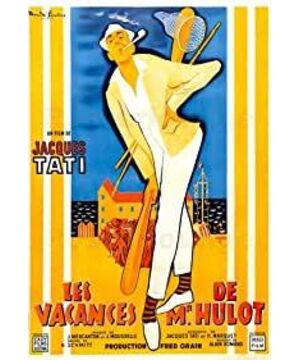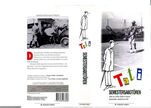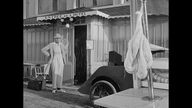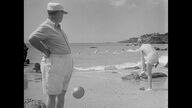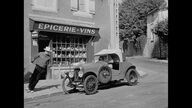some data collection
Bazin, M. Hulot and Time:
For Mr. Luo, there is no "plot" at all, because a story requires meaning, a direction of progression from cause to effect, a beginning and an end. On the contrary, "Mr. Hulot's Holiday" can only be a concatenation of time that is related to each other in meaning and independent in drama. Every episode of the protagonist's misfortune and misfortune can begin with this sentence: "Once again, Mr. Hulot..." Obviously, I have never seen such a way of using time as a material, and time has almost become the object of the film's description. It is even more perfect and fuller than the experimental film whose length is consistent with the time of the story. Hulot inspired how we should represent the temporal dimension of our movements.
The sound part contributes more to the film's time depth than the picture. This is also a major innovation of the earth, and it is the most unique in technology. It is often said that his innovation is some kind of cluttered sound effect, in which there are occasional fragments of words that are clearly distinguishable and thus more ridiculous, this is a misunderstanding, this is just an impression when you listen to it without paying attention. . In fact, there are not many slurring sound elements (such as announcements from station loudspeakers, but the gimmick is realistic). On the contrary, all the cleverness of the earth is to destroy clarity with clarity. Dialogue is by no means incomprehensible, but meaningless, and the meaninglessness of dialogue is revealed through the clarity of dialogue. In particular, Dadi uses the distortion of the loudness relationship of different sound levels to achieve this effect. He even often retains the sound of a scene outside the screen to set off the silent time in the screen. On the whole, the sound background in this kind of film is made up of real elements: dialogue fragments, shouts, arguments; however, no sound is strictly in a dramatic situation. An incongruous sound is particularly distorted compared to a sound background suitable for this. For example, a night in a hotel where travelers were reading, arguing, or playing cards: Hulot was playing table tennis, and the celluloid balls made a surprising noise. Once, the sound seemed to increase by a point. The real, recorded sound material on the beach is the basis of this film, and in the real sound comes unnatural sounds, which are still clearly discernible, but always detached. This real sound combined with this distorted sound creates the inevitable effect of sound being hollow and boring in this human world. Undoubtedly, the physical character of discourse, the anatomy of discourse, has never been so relentlessly shown in the past. We are accustomed to attaching a meaning to words, even if it has no meaning, and we do not mock language, often through visual imagery. In this film, however, the words are stripped of all suave sociality, and it seems that naked people wander there, grotesquely and indecently. We seemed to see some words float out of the radio like a string of red balloons, while others seemed to condense into clouds that circled over people's heads and then, fluttered in the wind, down to the tip of our noses. But, worst of all, these words just have meaning, and if you just close your eyes and listen to the outside noise with your heart, you will eventually discover their meaning. The earth sometimes sneaks in a completely false voice, but we're already involved in this mixed world of voices, and we don't expect to express disapproval.
Roger Ebert, The Great Movies, p349-p353:
"Mr. Hulot's Holiday" is not a hilarious comedy, but a mood of memory, nostalgia, fondness and joy. There are definitely places in the movie that make people laugh, but it brings us something rarer, a humorous, tender love for humanity—so strange, so important, so special.
"Mr. Hulot's Holiday" is a French film with almost no dialogue, like a silent film with music (a brisk melody played over and over again), lots of sound effects and rustling vocals. Tati is a silent clown who pantomimes a young man, and his Hulot never seems to get the hang of it.
The film is built on Keaton or Chaplin's meticulous attention to detail. The visual jokes are patiently arranged, almost revealing the hidden functions of the cosmic intricate machine. For example, in the scene where M. Hulot gives paint to a boat, the tide brings the paint pot into the sea and brings it ashore, just right under the brush. How did this scene come about? Was it a trick, or did Tati actually experiment with tide water and cans until he got the effect he wanted? Is this "funny"? No, it's simply a miracle. The sea didn't care about the person who painted it, but delivered the jar to him when needed, and life went on, and the boat was painted. Another example is the scene where Tati rowed a boat out to sea. The size of the boat was just as inappropriate for his size as his car. Hulot capsized in the sea. In another comedy, it just means the main character is soaking wet and we should laugh about it. But not here, the boat folded up like a shark, and everyone on the beach was startled. Hulot continued to be forgotten. There was almost a mental resignation in his behavior, everything didn't go according to plan, but nothing surprised him.
Let me try to explain my relationship with "Hulot" when I first saw the movie, I thought I was going to see a Hollywood-style neurocomedy. Instead, the movie opens with its lovely little melody, content with the continuation of life. Hulot went to the beach (disturbing a dog who wanted to sleep in the middle of the road) and tried to act as a well-behaved vacationer as possible. He was so polite he even took off his hat and bowed when the announcer on the radio said "Good night everyone!" Since there is no close-up, since the film does not particularly emphasize Hulot's identity, he becomes a spectator - he is me. I met all the people Hulot met and, like him, got used to their daily cruises. I followed him into a funeral, bewildered, mistaken for someone going to mourn, caught with him on a small rug, and tripped into the sea with the chains of a trailer.
Category of Comedy
(1) Classification of connotations according to ridiculous ingredients
Classification according to the content of the comic is one of the most common sayings in the country according to the content of the comedy. And each has obvious characteristics, so it is more clearly distinguished than the corresponding type of tragedy." That is, the content and form of comedy are analyzed, and comedy is divided into "farce, romantic comedy (humorous comedy), There are five types of emotional comedy (satirical comedy), conspiracy comedy, and customary comedy (funny comedy). It is not accurate enough to classify the comedy genre as a sixth genre outside of the first comedy genre, and Nissl's reference to "customary comedy, and perhaps his subcategory of gentle comedy" does not match, it is clear that in Nissl's In point of view, gentle comedy can be included within the scope of custom comedy.
(2) Classification of connotations according to thematic connotations
American dramatist Brockett, his standard for classifying comedy is expressed in three meanings: "the relative strengthening of the dramatic situation, characters or ideas, the degree of objectivity in the handling of the protagonist, and the nature and meaning of the dramatic action." On this basis, He divided comedies into three types: sitcoms, character comedies, and thought comedies, and classified farce, romantic comedy, satirical comedy, mannered comedy, and social comedy mentioned by Nicole into sitcoms, character comedies, and thought comedies, respectively. middle. Roche's first type of situation comedy refers to the comedic effect of being caught in a situation. For example: three sisters who want to participate in a masquerade party, because they have a common object of admiration, they also want to participate in the dance party. Therefore, the three sisters do not want to let each other know the fact of participating in the dance party. They do everything possible to cover up and hide at the dance party, so it is inevitable A series of dramatic actions take place in , and the reason for the comedy here is mainly the prescribed situation in which the three sisters are located, and the characters' thoughts appear to be second in comparison. In this type of comedy, there is no delicate carving and careful scrutiny on the character's character in comic comedy. Instead, it often relies on coincidences and unexpected situations. Usually, a single action of a character can resolve conflicts and conflicts. Roche's second type of character comedy refers to comedies that focus on the psychological description of characters. He classifies romantic comedies and satirical comedies into this type of comedy. He believes that romantic comedies are mostly about love disputes between lovely characters. Comedy mainly comes from the various ridiculous strategies and subsequent misunderstandings used by characters in the process of motives and actions, such as Molière's satirical comedies and Shakespeare's romantic comedies, because the common problems of the characters' characters are very obvious. The comedy development also revolves around the treatment of such people's characters. The third type of comedy, which Roche has studied most deeply, is the comedy of ideas. It mainly refers to the details that cause conflicts due to different concepts and ways of thinking. Thought comedy also includes ceremonial comedy and social comedy. The ceremonial comedy refers to those "characters who like to show wit and witty words", so they also It can be called the type of machine comedy, and his social comedy refers to "comedy that explores social values, behavioral standards, or ideological conventions, which can be called revision comedy." And he called tragicomedy melodrama , and called dramas with uncertain forms other than tragedy, comedy, and melodrama as "mixed forms". Obviously, Roche has a deeper understanding of the theme and connotation of comedy works. His taxonomy focuses on the dramatic excavation and research of comedy situations, characters, and ideas.
(3) Classification of connotations according to creative motivation
Mr. Ma Wenqi regards creative motivation as a common sense tool of comedy structure, and divides European comedy into four types: funny comedy, humorous comedy, satirical comedy and grotesque comedy. This kind of motivation occupies the dominant position of creation, which determines the dominant tendency of a comedy work.” These different tendencies constitute different types of comedy. Therefore, "the inclination of the work is given by the creator, and the creator can give shape to the work for different motives". This entry point has a certain rationality, and is very different from the first two categories according to the classification of laughing objects. It mainly starts from the creator's creative tendency as the subject of laughing, and grasps the playwright's creative motivation. The way of mastering comedy is different. The degree of imprinting leads to different comedy tendencies, so the essence of this classification method is to deal with comedy tendencies through the subject tendencies of laughter. , that is, the original intention of the author's words", the understanding is relatively consistent, focusing on the influence of the creator's psychological inclination on the work, so as to analyze the tiller and stereotype of the type of comedy presented in the history of comedy development. The conflict of important factors in the mastery of comedy is also affected by the motivation of creation.
Plot patterns for different genres of comedy
1. The plot mode of burlesque comedy
"The basis of comedy is ugliness, and comedy realizes beauty's ridicule of ugliness through the contradiction between content and form caused by the disharmony of things because of their self-settling." Bergson believes that "in the strict sense, human There is nothing funny outside of it," because comics are characterized by entertainment and cannot be branded with heavy social problems like satirical comedies. According to the contradiction and conflict of comic comedy, it is purely to express the characteristic of comedy, and farce, positive comedy, and happy comedy can be included in this category. Funny comedy cleverly links incongruous things or concepts into jokes, creates incongruent situations, creates incongruent characters, and incongruent language to unfold contradictions and conflicts, so that people can get pleasure in the process of laughing. But that doesn't mean that burlesque characters are vulgar, spoof, shallow, stupid, and ignorant. The characters of burlesque comedies are the source of comedy, but this does not mean that the overall presentation of burlesque comedies is crude and shallow, because burlesque comedies also focus on plot design. Ridiculous comedy is often less logical as the conflict unfolds, thus making the audience feel grotesque and unreasonable. The storyline of burlesque comedy is relatively simple, with burlesque as its main feature. Exaggeration, deformation, amusing, playing tricks, and having fun are the main features of burlesque comedy in the process of conflict development. Burlesque comedy adopts highly exaggerated and external characters in the setting of characters. It creates a purely comic effect by placing comic characters in bizarre and absurd plots, making various comic actions and speaking comic words. Funny comedy does not pay much attention to the in-depth exploration of the meaning and purpose of comedy, nor does it focus so much on creating a comedy in the process of conflict and conflict, but more on a nonsensical comedy atmosphere, which the audience feels. The result is an overall comic effect and style.
2. The plot mode of satirical comedy
In Molière's "The Nobleman", the nouveau riche of the vulgar bourgeoisie is striving to pursue the lifestyle of the aristocratic upper class, thus creating contradictions and conflicts in denying this unbalanced and unrealistic pursuit, creating comedy, and In Gogol's "The Imperial Commissioner", the edge refers to the bureaucratic system under the tsar's rule, so it is comical in the conflict of criticism of the bureaucracy; in the classic film "Rich and Noble", Peter · Sellers played the simple-minded gardener who turned bizarrely into a politician's staff and even nearly became the next president of the United States. Everyone interprets his words as a metaphor, even if the audience can easily be stunned by the comedy Attracted by sex, but the protagonist in the film is always kept in the dark, this is a comedy film with strong political satire, which confirms the breadth of content in satirical films, especially when some of them involve political satire The comedy films have the social function of addressing the current situation. Some satirical comedies have almost no language to amuse the audience, but people will still be immersed in the comedy atmosphere. Such works include Molière's "The Hypocrite", Gogol's "The Commissioner", and Shatin's "In Qixiangju in the Teahouse", Chinese opera works "Treading the Shaking Mother" and "Watching the Money Slave" are also good at telling the world a warning in laughter and scolding. Satirical comedy draws on the plot mode of comic comedy, especially focusing on the creation of comic characters and language to weave a comic plot, but in the use of plot, satirical comedy has a unique feature, that is, it focuses on the portrayal of negative characters. For example, in "The Imperial Commissioner", although the core of the characters' contradictions and conflicts are also counterfeiting and misunderstanding, the order of the two is different. Khlestakov is first misunderstood and "taken as..." He gave full play to the incongruity of his character and made a series of comedy behaviors. "If playing a simple prank is the essential feature of comic comedy, then the most essential aesthetic feature of satirical comedy is to create negative comedy characters." ① Since the process of showing contradictions and conflicts is the most important way to express the characteristics of characters, therefore, The creation of negative characters must be accomplished through the unfolding of the contradictions of satirical comedy.
Three, humorous comedy plot mode
Humorous comedy is such a mode, the playwrights are no longer a single attitude towards the creative tendencies of the characters in the works, expressing those ugly perverts that do not cause pain, the main body of creation is an open-minded attitude, and overall. On the other hand, there is a positive tendency towards the good qualities of the characters in the play. The playwright makes fun of the shortcomings and deficiencies of the characters in the play. This kind of ridicule is a kind of prank with a kind, sympathetic, and loving vision. The ultimate meaning is different from the kind of jokes made by a cold face in satirical comedies, because the playwrights of humorous comedies hold an attitude of tolerance, sympathy, understanding, and forgiveness towards the characters in the play, while the protagonists of humorous comedies pursue. The purpose of the hero is often justified, reasonable, and has a positive meaning. Although the activities of the protagonist to achieve the goal are often contrary to the goal, the desire of the protagonist can be fulfilled in the end.
(1) The inconsistency between the objective requirements of aesthetics and the comedy
Humorous comedy expresses positive comedy characters by developing the plot through the contradiction between aesthetic requirements and comedy requirements. "When ugliness is consistent with falsehood and evil, and the incongruity of things is caused by the contradiction between meaningful content and seemingly absurd form caused by the incongruity of things, the laughter of the aesthetic subject has no effect on the object's Negation is a form of negation, a logical negation, and what we get at this time is the affirmative comedy and the positive comedy characters of 'beauty in ugliness'." ① In comic comedies and satirical comedies, it is developed by denying ugliness Contradictions and conflicts, while "when the ugly is consistent with the false and the evil, when the discordant state of things is caused by the contradiction between the empty content and the form that pretends to be meaningful, the laughter of the aesthetic subject negates the object. It is a kind of essential negation and moral negation, and what we get at this time is a negative comedy and a negative comedy character of 'ugly and self-showing beauty'. A kind of inversion of ugliness, in which beauty is reversed and distorted into ugliness, is humor.” ③ “The author often holds a positive attitude towards the protagonists of humorous comedies. Therefore, the essence of humorous comedies is the objective requirement of aesthetics and the requirement of judging ugliness. Inconsistency, for example, is reflected in the contradictions and conflicts of humorous comedies. The characters in humorous comedies often end with the fulfillment of their own wishes. This makes the humorous comedy more advanced than the purely entertaining purpose of the humorous comedy. Although, in the creation of dramatic situations, the humorous comedy is still based on the plot mode in the humorous comedy: such as the plot that mainly relies on conspiracy and misunderstanding. Design comedy plots, rely on machinery and chain reactions to develop comedy plots, and rely on the transformation of comedy characters' perspectives to resolve conflicts. The master, one is Raspo you, who disguised herself as a man and came to Venice to find her fiancé, and the other is her fiancé, Aletoui. In order to get married to another lover, Ruffalkin used his wit to trigger a series of interesting stories. I found the right person from it, and ended with a big reunion. The movement in the dramatic situation constructed in "One Servant and Two Masters" is basically similar to that of comic comedy, but the development of the plot mode of comic comedy is more advanced than that of comic comedy. , through the development and resolution of conflicts, humorous comedy is no longer simply comicality, but seeks the meaning and purpose of comicality through the discussion of the value and significance of comic characters' behavior patterns. It is worth noting that in the humorous comedy, there is another part of the black humorous comedy, "It is an extreme form of humor, a perverted comedy with a tragic color, which embodies the profound spirit of entertainment to death, ”①Black humor is based on self-deprecating and unconsciously excavating its own comic effect to make people think about the contradictions and conflicts faced by characters. In terms of expressive function, black humor is similar to satirical comedy, but it is different from satirical comedy. In order to ridicule and criticize in a way, black humorous comedies achieve the purpose of making people think by denying themselves, so the contradictions and conflicts of black humorous comedies have a strong tragic spirit. Black comedy is more restrained than satirical comedy. The atmosphere of comedy is created by the extrovert, and turned to self-dissection and self-deprecating. Therefore, black comedy does not focus on the simple comic effect, but with a strong absurdity, and even Brutal, darkly humorous comedy is downright tragic at its core.
(2) Affirmative Characters Transition from Good Times to Adversity
The comedy characters of humorous comedies often have insignificant defects due to the lag and restraint of concepts, which are incompatible with the environment, but such defects are not so obvious as those in humorous comedies and satirical comedies, so as to cause the audience to be attracted to the characters. The denial of flaws and inadequacies. If humorous comic characters also have comic masks, then this mask is a kind of "pretentious people are comical, and their masks are among the most ridiculous and innocuous masks in the Museum of Humanity, because from a psychological point of view See, rationality, like other emotions, is a result of heredity, and is an emotion that pursues harmony and order.” Here, the pursuit of harmony and order can be understood as the integrity of the character, and humorous comedy characters often have a harmless comedy that pursues integrity. Masks, such masks are mostly cognitive deviations. In humorous comedies, characters are often in a kind of adversity at first. They are usually self-identity and what they do are in a dislocation of "being treated as..." In the plot arrangement, this kind of plot transformation also has the creator's affirmative tendency, which makes the humorous characters' own shortcomings that do not arouse people's disgust become a source of comedy, and then From time to time in the development of the plot, these cute little flaws in the protagonists are magnified and emphasized, and they are trapped in a mode of adversity to create comedy. When the humorous comedy characters remove the cognitive bias in the mask, they turn. In the good times, this turning point is mostly for them to find that they have overcome this innocuous little shortcoming, and finally moved to a good mode. It is worth noting that humorous comedies have further developed compared with the previous two types of comedies in the narrative skills of developing and resolving conflicts. In particular, some of Shakespeare's humorous comedies often use the plot mode constructed by multiple clues. In the process of the development of conflicts and conflicts, they complement each other and become cause and effect. For example, in "The Twelfth Night", "The Families" and "A Midsummer Night's Dream", when multiple clues progress in parallel within the plot frame, the fate pattern of the main characters in the main plot contains the author's affirmation Sexual orientation, so the main character of the main plot is a journey from adversity to prosperity.
4. The plot mode of the grotesque comedy
The plot structure of grotesque comedy is completely different from that of classical comedy, and the contradictions and conflicts in its plot are also very different from other types of comedies. Although the core of grotesque comedy is influenced by modernism, the playwright looks at it from a reflexive perspective. Human beings themselves lack a clear scale for their creative tendencies, and the scale here refers to "the reason why the authenticity of representation is not measured by the accuracy of representation is that representation does not reveal the objectified universe known by science, It is the truth of a world perceived by subjectivity.” ① Their contradictions and conflicts are either irreconcilable and distorted, or they are ready to be resolved but because of the destruction of the resolution scale, the resolution of conflicts and conflicts are unhappy, and the conflicts are thus caught in cannot be resolved.
(1) Conflicts that cannot be resolved by grotesque comedies
If the contradictions of the grotesque comedy are resolved, the grotesque characters, motives, and behaviors of the original characters become comically pleasing and confusing. If the contradictions of the grotesque comedy are resolved, the incongruity becomes, in "The Bald Showgirl," when Mary says that the Martins' daughter Alice's eyes are different colors because of her contact lenses. Pointless hilarious favoritism or prank. In the same way, once the contradiction in the prescribed situation of the character can be resolved, it also becomes a false cage that can be broken through and changed. For example, in Brecht's "Sichuan Good Man", the angel Shen Dai falls into the unbreakable after coming to the world. The cage of the grotesque comedy, the contradictions and conflicts in the language of the grotesque comedy are equally unresolvable, and once resolved at the end, the language becomes like nonsense and rambling. The unresolved conflict is the core of grotesque comedy, but not any grotesque comedy needs to satisfy the three essential factors of situation, characters, and language conflicts cannot be resolved. Sometimes, it only needs to have the contradictions of situation and characters. Unresolved conflicts can constitute the existence of grotesque comedies, such as Bernard Shaw and Brecht's grotesque comedies, and the contradictions and conflicts of language become relatively secondary. The reason why the contradictions and conflicts of grotesque comedies cannot be resolved is because the scale is eroded by relativism, skepticism, and debateism, resulting in a perverted sense of sadness or carnival that cannot be resolved. The audience is keen to discuss contradictions and conflicts, otherwise the audience's keen discussion of grotesque comedy will be boring. This kind of unresolved conflict can only be "mutated" and "deconstructed", and the mutation is mainly through the intervention and change of the behavioral patterns of the characters in classical comedy. "Any variation of social and subjective factors may The change of its internal contradictions affects the comedy aesthetic effect; and the interaction of multiple contradictions and the variation of various factors must be incorporated into specific game rules to produce a realistic comedy effect.”2 Deconstruction is based on metaphysical philosophy. Perspective, subverting the traditional thinking with logic as the center, completely replacing and dissolving binary opposition, thus subverting and rebuilding the traditional drama structure of drama. The grotesque comedy returns to the original uncertain form and exploration of artistic creation "on the one hand, it imposes absolute meaning on the most mundane objects, and on the other hand, it reluctantly calls the natural phenomenon the expression of its world view, so it appears grotesque. Bizarre." ③ This uncertainty and openness must be imprinted on the dramatic structure. "If there is also a creative mode of grotesque comedy, then this mode can be summed up as open ending or anti-logic and grotesque technique."① Another part of grotesque comedies is to use comedy to illustrate the theme of deep tragedy, these comedies have the core of tragedy and the form of comedy, "it combines the theme and form of traditional tragedy and comedy, and the characters in the play often There is a series of serious actions, which foreshadow the tragic ending of the protagonist; but due to a sudden reversal of fate, the protagonist has a perfect ending, and the tragicomic dominance is also used to indicate that there is a "double plot", the main plot is serious and the subplot is funny — the drama.” ② “It is not designed to make tragedy more bearable because of the lightness of its tone: it does not remove tragedy, no, it destroys tragedy in its bud.” ③ In Contradictions and Conflicts in Tragic Comedy Through the symbiosis and coexistence of tragedy and comedy, the tragic and comedy have achieved harmony and unity. "That's not because comedy and tragedy are similar, but because comedy often overlaps with the trajectory of tragedy." (4) Tragedy is not the opposite of comedy, but coexists as a part of comedy, which reflects the ultimate concern of the mean. For example, in Dylan Matt's "The Return of the Old Woman", the proposition the author deals with is the absurdity of the proposition "the omnipotence of money", but the comic ending of the play just proves that "the omnipotence of money" Feasibility: Klean, a billionaire in his 60s, returned to her hometown after vicissitudes of life and disabled. In response, the mayor pinned his hopes on Klean's young lover, Il, and bribed Il by various means, and even promised Il to replace him. But Klein's real purpose in coming to Gulen City is not to give back but to retaliate. She promised to give Gulen City one billion yuan, but she must get justice for herself and kill Il. Although the mayor refused to donate on behalf of the citizens, but Still unable to resist the impact of money, although no one in Gulen City killed Il directly, the omnipotence of money killed Il. In this play, Dylan Matt uses grotesque dramatic techniques to dissect the core of conflicts and conflicts. "Money is omnipotent, but it is absolutely impossible." outstanding performance.
(2) The control strategy of the reflexive perspective of grotesque comedy
The reason why this kind of contradiction and conflict cannot be resolved is because the playwright's own creative tendency is full of contradictions, relatives, doubts, and an open attitude. This tendency comes from the playwright's unique perspective on life. It is mentioned in "Study on the Situation of Pai Drama": "This kind of perspective that reflects the absurdity of human beings is not only different from the upward perspective of tragedy, but also different from the downward perspective of comedy, and also different from the horizontal perspective of drama, we call this perspective. This is the reflexive perspective" ①. Martin Esslin believes that the absurdist dramatist is based on the grotesque and chaotic imagery that suddenly confronts the audience with a mad world, a distancing approach that prohibits the audience from identifying with the characters on the stage, and instead in a calm, critical manner. "Humans have a special ability to take a step back and look at themselves and the life they are involved in. They use that detached look they use to watch an ant struggle to climb up a pile of sand. They don't They don't fantasize about being able to escape from their very special peculiar situation, but they can see it in an eternal form, and they see a scene that is both solemn and ridiculous."2 Therefore, the reflexive perspective requires a relationship between the laughing subject and the laughing object. Keeping an absolute distance, the laughing subject can freely watch and calmly question the laughing object. Blow once defined the concept of "distance". "Distance... It is obtained by separating itself from its actual needs and purposes... ③ When the subject of the laugh looks at the comic characters from a top-down perspective, he will be amused by the comical absurdity of the characters in the play, but when they When looking at the characters in the play from a head-up perspective, they can associate the sadness of their own situation and the pure experience of the nature of the world they live in through the characters in the play. Therefore, this is a kind of sadness and joy brought by a reverse perspective. Interwoven experience. Although the plot mode of grotesque comedies is very different from funny comedies, humorous comedies and satirical comedies, the creation methods of grotesque comedies are also inseparable from the development and resolution of conflicts, and the comedy effects produced by them must not be able to To bring the audience an experience of pure sadness, but an experience with a comic inclination, it must selectively avoid the tragic. To sum up, in the grotesque comedy, it produces contradictions and conflicts, but also controls and dissolves the conflicts at will. It touches the alienation and distortion of contradictions and conflicts, but it defamiliarizes them. It unfolds contradictions and conflicts. But it also suppresses and transforms contradictions. All the ways of dealing with contradictions and conflicts cannot lead to the complete resolution of contradictions and conflicts. The psychological tendency of the laughing subject plays an absolutely dominant position here. Therefore, it can be said that grotesque comedy is such a According to this mode, grotesque comedy is the movement of a more meaningless and uncertain entity after an uncertain movement of an objective entity without a clear meaning and uncertainty. Because grotesque comedies do not clearly resolve conflicts, many conflicts still show unresolved and meaningful forms. Nevertheless, our discussion of grotesque comedies is still inseparable from the most basic creations such as situations, characters, and language in the plot. means.
View more about Monsieur Hulot's Holiday reviews


